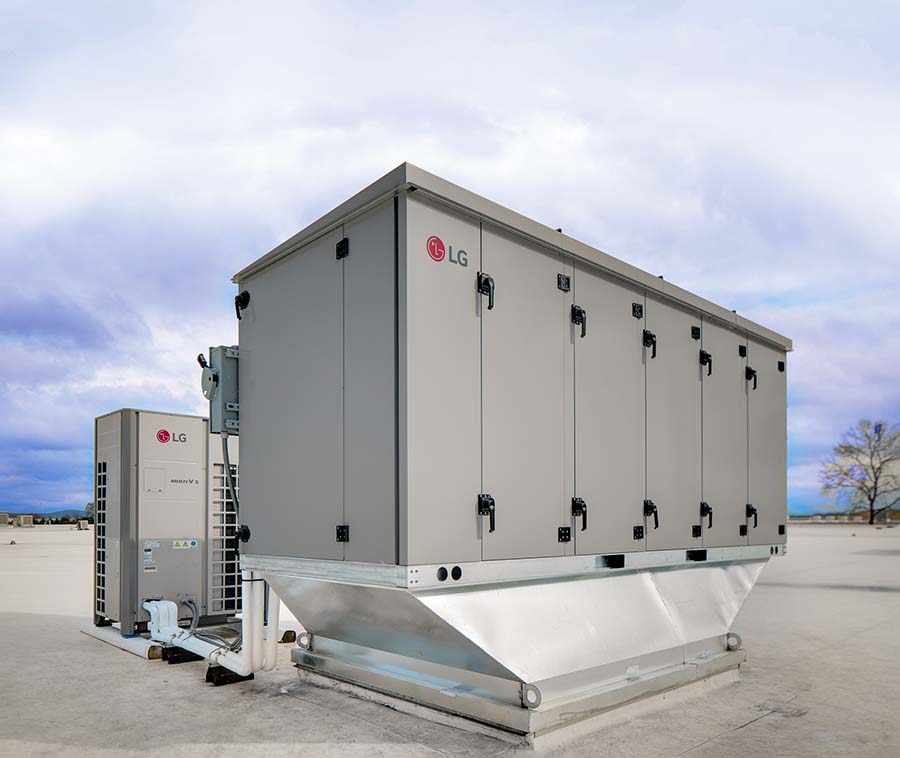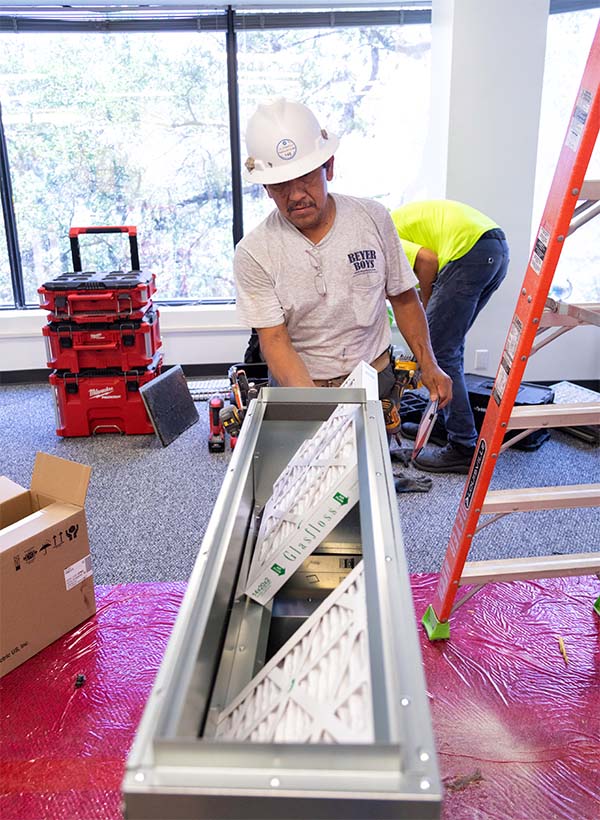The pandemic has caused indoor air quality to become a bigger concern for many commercial building owners and managers, due to the fact that the COVID-19 virus is primarily spread through the air. This has led industry experts, including ASHRAE, to recommend increasing ventilation and upgrading filtration in order to help mitigate the transmission of the virus.
With VRF systems, the best practice usually calls for providing a separate mechanical ventilation system to ensure enough outdoor air is being introduced to the occupied space. The two products most often paired with VRF systems are energy recovery ventilators (ERVs) and dedicated outside air systems (DOAS), and both can typically be used in new and existing buildings.
Ventilation Strategies
VRF indoor units are designed primarily for 100% return air when used as prescribed and work best with a coupled or decoupled ventilation system, said Ed Ferrier, product manager at LG Air Conditioning Technologies, LG Electronics, USA Inc. He described some of the available ventilation strategies offered from LG:

FULL RANGE: LG’s split DOAS units range from 1,000 to 3,000 cfm and connect to LG’s outdoor condensing units. Courtesy of LG.
- Packaged DOAS units dehumidify/cool/heat code-required ventilation air and can operate as stand-alone units or can be interlocked to VRF touchscreen controls (like the LG AC Smart) that allow the users to easily view and control both DOAS and VRF systems. These units range in size from 3 to 70 tons and are highly configurable, with options including energy recovery wheels, inverter compressors, and modulating condenser fan motors.
- Split DOAS units (split RT DOAS and split compact DOAS) dehumidify/cool/heat code-required ventilation air and include a factory-installed heat recovery section, modulating hot gas reheat coils, and microprocessor controls with user-friendly graphics. Split DOAS units range from 1,000 to 3,000 cfm and connect to LG’s outdoor condensing units (ODUs).
- ERVs precondition ventilation air using supply and exhaust fans to extract energy from building air before it is exhausted outdoors. ERVs range from 300 to 1,200 cfm, and their fixed core heat exchanger dehumidifies/cools/heats ventilation air with fewer moving parts.
- Outdoor air units (OAUs) mechanically precondition ventilation air using a single refrigerant coil and can be combined on the same refrigerant system with standard VRF indoor units. OAUs range in size from 500 to 1,200 cfm.
- Air handling unit (AHU) kits allow connection of third-party DOAS units to LG ODUs, taking advantage of energy-saving opportunities with invertor compressor technology and heat pump heat for areas that can no longer use fossil fuels for heating.
While mechanical ventilation may not always be needed, if it is, then Mark Wieland, airstage sales engineer for the Southeast region at Fujitsu General America, usually recommends decoupling the provision of outside air with the VRF to avoid the challenge of placing a false load on the VRF equipment. A false load can make the VRF indoor unit react to these altered conditions, rather than reacting — as they should — to space-conditioning needs.
“If the provision of outside air is handled separately, there are key advantages, such as the system designer’s ability to build-in a heat recovery ventilation (HRV) or an ERV function, DOAS, or even the combining of methods to handle the latent load,” he said. “That way, the VRF’s capabilities can be focused on maintaining comfort conditions to the sensible load, doing exactly what it’s what it’s designed to do. Everyone stays in their lane.”
Fujitsu offers indoor units that can accept 100% outside air that can be tempered down to 64°F, even if outdoor temps rise to 95°F, said Wieland. If neutral air is necessary, stand-alone outside air processing equipment can be used in conjunction with their air conditioning, heat pump, multizone, or VRF condensing unit.

UPGRADED FILTERS: Beyer Mechanical installs a METUS VRF system, which offers the option for upgraded air filters. (Courtesy of Troy Fields Photography)
Several City Multi VRF indoor unit styles from Mitsubishi Electric Trane HVAC US (METUS) can accommodate ventilation air either with a fresh air knock out or by mixing ventilation into the return of a ducted indoor unit, said Joe Cefaly, senior manager of applications at METUS. However, the company still recommends treating ventilation air with an ERV or DOAS before introducing the ventilation air to indoor units, especially in high-humidity climates.
“Our zoned ventilation solutions are a perfect match to VRF systems in respect to the symmetry of design, product lifespan, and efficiency,” he said. “Our City Multi PEFY-OA ducted outside air units and PEFY-AF ducted outside air CFM/CFMR units provide zoned comfort by supplying pre-conditioned outdoor air to each zone. The PEFY-OA introduces filtered and conditioned air into the zone but doesn't have reheat, while the PEFY-AF introduces room-neutral ventilation to the occupied space. Zoned ventilation solutions provide energy savings for building owners and allow for precise zone management when it comes to IAQ needs.”
Installation Guidance
The type and size of the ventilation system specified for a particular application will be driven by a number of factors, including occupancy type, location, climate, and codes/standards, said Cefaly.
“ERVs work well in moderate and dry climates, while a DOAS is recommended for climates subject to high humidity levels and more severe design conditions,” he said. “For example, an office application on the West Coast will likely use ERVs, while a school application on the East Coast will use a DOAS.”
Ventilation systems can also use a lot of energy, so in order to reduce energy consumption, METUS recommends installing proper controls. This will ensure accurate occupancy schedules and provide the ability to adjust the ventilation rate based upon CO2 levels, as well as properly integrate the VRF and ventilation system and limit reheat use, said Cefaly. He added that proper system sizing, system selection, and maintenance can also reduce energy consumption.
Before specifying any mechanical ventilation system, contractors should first familiarize themselves with the local ventilation code, which is usually based upon ASHRAE Standard 62.1 and specifies the amount of ventilation air required for all buildings, said Ferrier. Contractors should also consult with their local manufacturer’s sales representative to find out which ventilation system best fits the application.
“ERV and OAU units pre-treat the incoming ventilation air and should be ducted to a secondary mechanical system (VRF indoor unit or OAU) for full dehumidification/cooling/heating of the ventilation air before it is distributed to the building occupants,” he said. “In cold climates, ERV wheel defrost controls options (i.e., modulating wheel controls or cycle on/off controls) should be selected to maintain full operational efficiencies of the ERV wheel.”
Ferrier advises using the manufacturer’s selection software in order to properly size the ventilation system based on design ambient temperatures. He added that DOAS units should always be sized to cool the ventilation air down to 55°F or lower off the main coil for dehumidification mode. Air-source heat pump DOAS units may also require secondary heat sources when entering air temperatures fall below equipment minimum entering air temperature limits.
Facility managers will also likely be concerned about the need to control IAQ conditions, so in a retrofit situation, it is useful to know if the existing VRF system has a built-in function for control of ventilation or whether it can be accommodated, said Wieland.
“There are many ways to improve IAQ, and each has advantages and disadvantages,” he said. “Of course, the solution must be cost-effective, but also consider the impact on system design and — if applicable — the system or building retrofits required. Is ductwork required? Filtration? What’s the impact on up-front cost for equipment, installation labor, and maintenance? Ventilation may be a game changer, but it’s good to be realistic when seeking an approach to designing a new HVAC system or retrofitting an existing one.”
Filtration and Other IAQ Options
In addition to ventilation solutions, OEMs offer a wide variety of other IAQ options designed to enhance their VRF systems. For example, there are many different types of filtration, each designed to meet a specific need — from simple filters that remove airborne particulates to more advanced filters that maintain tighter control of indoor conditions, said Wieland.
“MERV filters — grades from 1 to 16 — capture airborne particulates of varying size, from .03 to 10 microns, while HEPA filters meet even more stringent demands and have the ability to stop even airborne pathogens and bacteria,” he said. “A key consideration when looking at filtration, however, is the static pressure — or resistance — that filters place on the ventilation system. Ventilation systems must be able to accommodate the additional static pressure of whatever filtration is installed.”
UV lights can also be used, said Wieland. While UV lights can be used essentially anywhere within a ducted system, the best location for them to be installed is where the pathogens grow — typically in the coil drain pan, where it’s darkest and damp, he said.
In addition to increased ventilation rates, METUS VRF systems offer the option for upgraded air filters, which can be retrofitted into most existing VRF systems, said Cefaly. “MERV 13 filter boxes can be added to most ducted indoor units or large ceiling cassette units. Lossnay ERVs are available with an optional MERV 16 filter, and PremiSys DOAS offers MERV 13 filtration.”
LG DOAS units come standard with MERV 8 rated filters, and the packaged DOAS units have options for up to MERV 13/14 rated filters, said Ferrier. Packaged DOAS units come with options for UV lights and bipolar ionizers.



Report Abusive Comment